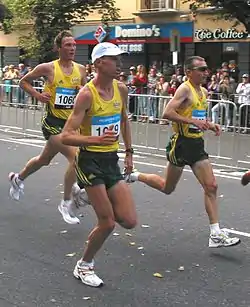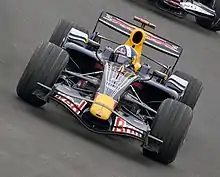Adventure racing
Adventure racing (also called expedition racing) is typically a multidisciplinary team sport involving navigation over an unmarked wilderness course with races extending anywhere from two hours up to two weeks in length. (What Is Adventure Racing Video) Some races offer solo competition as well. The principal disciplines in adventure racing include trekking, mountain biking, and paddling although races can incorporate a multitude of other disciplines including climbing, abseiling, horse riding, skiing and white water rafting.[1] Teams generally vary in gender mix and in size from two to five competitors, however, the premier format is considered to be mixed gender teams of four racers. There is typically no suspension of the clock during races, irrespective of length; elapsed competition time runs concurrently with real time, and competitors must choose if or when to rest.
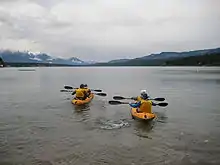
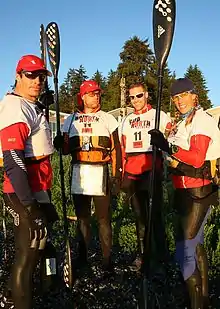
Origin
The roots of adventure racing are deep and people debate the origin of the modern adventure race. Some point to the two-day Karrimor International Mountain Marathon, first held in 1968 as the birth of modern adventure racing. The Karrimor Marathon required two-person teams to traverse mountainous terrain while carrying all the supplies required to support themselves through the double-length marathon run.
In 1980, the Alpine Ironman was held in New Zealand. Individual competitors ran, paddled and skied to a distant finish line. Later that year, the Alpine Ironman's creator, Robin Judkins launched the better-known Coast to Coast race,[2] which involved most of the elements of modern adventure racing: trail running, cycling and paddling. Australia's 2-day WildTrek ran from 1981 through 2005.
Independently in 1982, the first expedition-length adventure race, a week-long, North American event called the Alaska Mountain Wilderness Classic debuted. The Classic involved wilderness travel—no roads, no pack animals, and no support teams, carry all food and equipment from start to finish—with less than 50 of its 150-mile length on trail. It continues today, changing courses every 3 years.
Modern adventure racing
In 1989, the modern era of adventure racing arrived with Gerald Fusil's launch of the Raid Gauloises in New Zealand. Inspired by the Paris-Dakar Rally, Fusil envisioned an expanded expedition-style race in which competitors would rely on their own strength and abilities to traverse great and challenging terrain. The race included all the modern elements of adventure racing, including mixed-gender teams competing in a multi-day 400+ mile race. Building on Fusil's concept, the inaugural Southern Traverse was held in 1991.
In the early 1990s, Mark Burnett read an Los Angeles Times article[3] about Raid Gauloises and was inspired to compete and bring the race to the USA and promote the race as a major televised sporting event.[4] After purchasing the rights from Gerald Fusil, Burnett launched the first "Eco-Challenge" race in 1995. Burnett promoted his event with Emmy-award-winning films (tapping the talent of Mike Sears to produce the films for the first two events). This incarnation of Eco-Challenge was last held in 2002 when Burnett shifted his focus to Survivor, the Contender, the Apprentice and other reality-based television shows. With the Eco-Challenge also came the name "adventure race", a phrase coined by journalist and author Martin Dugard, to describe the class of races embodied by the Raid and Eco-Challenge.
The United States Adventure Racing Association "USARA" was formed in 1998. The USARA was the first "national governing body" for the sport of adventure racing and arose from the need for safety standards, insurance and to promote the growth of adventure racing in the United States. The USARA has added national rankings, a national championship, ecological standards to the list of benefits provided for the sport of adventure racing.
In 2000, the inaugural United States Adventure Racing Association Adventure Race National Championship was held in Kernville, California. The USARA National Championship is typically held the first weekend in October and is considered the premier adventure race in the U.S. The USARA Adventure Racing National Championship has continued each year drawing the best US teams for a chance at earning the title of national champion.
In 2001, the inaugural World Championships were held in Switzerland with Team Nokia Adventure crossing the finishing line first. The concept of a world championship lay dormant until it was revived in 2004, with Canada's Raid the North Extreme serving as the AR World Championship event in Newfoundland & Labrador. The Adventure Racing World Series and its ultimate event, the AR World Championships have been held every year since. The 2013 World Championships were in Costa Rica, 2014 in Ecuador, 2015 in Brazil, 2016 in Australia, 2017 in the United States and 2018 off the coast of Africa on the Reunion Island.
In 2002, the first major expedition length race to be held exclusively in the United States was launched. Primal Quest has been sporadically held since its inception - about 6 times from 2002 to 2017. In 2004, the death of veteran racer Nigel Aylott over-shadowed the race, and raised debates about the nature of Primal Quest and adventure racing.
In 2004, professional geologist Stjepan Pavicic organized the first Patagonian Expedition Race at the bottom tip of the American continent, in the Chilean Tierra del Fuego. Truly demanding routes through rough terrain of often more than 600 km soon made it be known as “the last wild race”.
In 2010, the German Adventure Race Series were held for the first time in three different locations all over Germany. Since then the popularity of the sport in Germany has grown every year. More races and venues have joined the series and the number of competitors are still growing from year to year. Competitors can start in teams of two (male, female or mixed) within the categories Master (15–20 h), Challenger (8–10 h) or Beginner (4–6 h).
In 2012, Commander Forer of the Royal Navy organized the first Sea-land navigation discipline race The Solent Amphibious Challenge. The race demanded the competitors to split up between sailing, running, and cycling in parts of the race and rendezvous at the end and sail the yacht to the finish line.
In December 2017, the Adventure Racing Cooperative (ARC) was launched in the United States. It was formed in a grassroots movement to help promote and expand the sport of Adventure Racing in the United States. ARC is a 501(c)(3) not-for-profit business.
In May 2018 World OCR, the world governing body for Obstacle Sports and related disciplines announced the Expedition OCR World Championships in collaboration with Primal Quest to be held in September 2018.[5]
In June 2018 Eco-Challenge announced it would re-launch in 2019 with Bear Grylls and the original production team[6]
Race types
Lengths
- Sprint: typically a two- to six-hour race, featuring minimal navigation and occasionally involving games or special tests of agility or cunning.
- 12-Hour: a six- to twelve-hour race, featuring limited navigation and orienteering.
- 24-Hour: a race lasting between 18-30+ hours, typically involving UTM-based (Universal Transverse Mercator) navigation. Often basic rope work is involved (e.g., traverses or rappels). 24-hour and longer races used to require that competitors employ a support crew to transport gear from place to place. Most races these days do not permit support crews, with race organizers transporting gear bins to designated checkpoints for racers.
- Multi-day: a 36–48+ hour race, involving advanced navigation and route choice; sleep deprivation becomes a significant factor.
- Expedition: Three- to 11-day race (or longer), involving all the challenges of a multi-day race, but often with additional disciplines (e.g., horseback riding, unusual paddling events, extensive mountaineering and rope work).
Disciplines
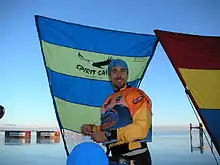
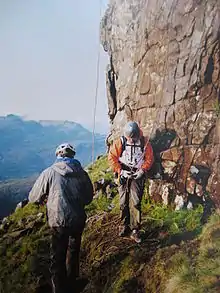
The majority of adventure races include trail running, mountain biking and a paddling event. Navigation and rope work are also featured in all but the shortest races. Races often feature:
- Paddling: kayaks, canoes, out-riggers, rafts and tubing;
- Traveling on wheels: Mountain Bikes, kick-scooters, in-line skates, roller skates;
- Beasts of Burden: Horses and camels;
- Catching Air: Paragliding, hang-gliding;
- Covering Terrain: Orienteering, mountaineering, coasteering, caving, swimming, canyoneering, riverboarding;
- Learning the Ropes: Ascending; rappelling, traversing (including via zip-line).
Overview
Rules
The rules of adventure racing vary by race. However, virtually all races include the rules of racing:
- no motorized travel;
- navigation;
- teams must travel together the entire race, usually within 50 meters of each other;
- no outside assistance except at designated transition areas (assistance from competing teams is generally permitted at all times); and
- teams must carry all mandatory gear.
Organizational meeting
Typically races will feature an organizational meeting either the night before or the morning of the race. At this meeting the course will be revealed for the first time. For sprints, racers may follow a marked course. For longer races, racers may be given maps marked to show checkpoints ("CPs") or racers may be simply given a topographical map and coordinates (usually UTM coordinates) that indicate where the CPs will be found. Special rules, last minute changes and other information may also be provided at the meeting.
Checkpoints
Racers are required to visit a series of checkpoints or passport controls (CPs), usually in a specific order.
Transition areas
Most races include one or more transition areas that teams can visit to replenish supplies. Typically, teams change to another mode of travel in a transition area. For instance, teams will end a trekking leg and transition to mountain biking in a transition area. Shorter races often feature a single transition area that teams may visit numerous times during the event. Teams will leave food, water, paddling and biking gear, fresh clothing and any other items they may need during the course of the race.
Longer races feature multiple transition areas. Team gear is transported either by a support crew (provided by the team) or by the racing staff.
Gear check
Virtually all adventure races feature mandatory gear that must be carried during part or all of the race. Races will often include mandatory pre-race gear checks by race personnel and harsh penalties or disqualification may result if a team lacks the requisite equipment.
In addition to pre-race gear checks, many race organizers also include on-course gear checks. This helps to ensure that teams that start with approved gear, compete with, and finish a race with that same gear.
Short course
Adventure races attract individuals of greatly divergent abilities. To make the sport more inclusive, many race directors will "short course" racers; allow racers who miss mandatory time cut-offs to continue racing on a reduced-length course. These racers will often earn an official finish time but be "unranked" and not eligible for prizes. Some races provide the option for teams to skip certain CPs but incur a time penalty (which often must be "served" during the race).
Teamwork
Most adventure races are team events, with expedition length races typically requiring a set number of teammates (usually four or five) and requiring the teams to be co-ed. Many racers find the team aspect of adventure racing to be among the most enticing and demanding aspects.
Teams typically elect a team captain and designate a team navigator. Teams have different views as to the functions of each of these positions, with some teams having very little structure, while others assigned specifics rights and responsibilities to each of these persons. For example, a team that stresses a democratic philosophy may limit the captain’s role to be the keeper of the racing passport and rules, and limit the navigator’s role to carrying the map and being primarily responsible for determining the team’s position at any given time. A more regimented team may give the captain ultimate responsibility for making all decisions regarding rest schedules, rule interpretations and the like, while the navigator has full responsibility for not only tracking the team’s location, but determining route choice as well.
References
- "Adventure Racing 101". USARA. AR Pathfinder. Missing or empty
|url=(help) - "Home » Coast to Coast". www.coasttocoast.co.nz. Retrieved 2018-06-09.
- MARKMAN, JON D. (1991-02-27). "Last Among Finishers, but First in Their Own Hearts". Los Angeles Times. ISSN 0458-3035. Retrieved 2018-06-09.
- KLEIN, GARY (1994-03-05). "Topanga Man Seeking to Stage Race of Endurance : Adventure: The event would be a California version of the Raid Gauloises, a 300-mile contest. Obtaining permits is key obstacle". Los Angeles Times. ISSN 0458-3035. Retrieved 2018-06-09.
- "Primal Quest Slated to Host Expedition OCR World Championship | Mud Run, Obstacle Course Race & Ninja Warrior Guide". Mud Run, Obstacle Course Race & Ninja Warrior Guide. 2018-05-30. Retrieved 2018-06-09.
- Littleton, Cynthia (2018-06-07). "Bear Grylls and Mark Burnett Team to Revive 'Eco-Challenge' Race Franchise". Variety. Retrieved 2018-06-09.
Further reading
- Adventure Racing by Jacques Marais and Lisa de Speville. ISBN 0-7360-5911-3
- Runner's World Guide to Adventure Racing: How to Become a Successful Racer and Adventure Athlete (Runners World) by Ian Adamson. ISBN 1-57954-836-9
- Adventure Racing: The Ultimate Guide by Liz Caldwell and Barry Siff. ISBN 1-884737-90-0
- The Complete Guide to Adventure Racing: An Insider’s Guide to the Greatest Sport on Earth by Don Mann and Kara Schaad. ISBN 1-57826-064-7
- Surviving the Toughest Race on Earth by Martin Dugard. ISBN 0-07-135821-8
- Squiggly Lines: Map and Compass Navigation with a Focus on Adventure Racing and Rogaining by Mark Lattanzi ISBN 978-0-473-38677-1
External links
Race Organizations/Websites
